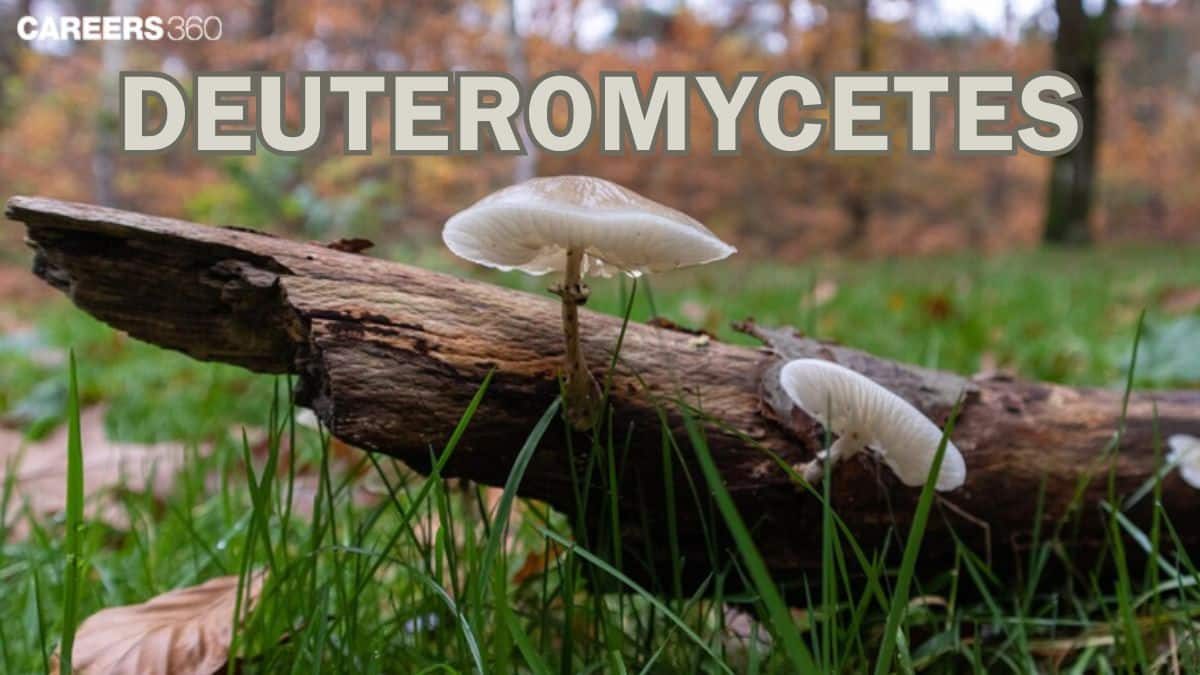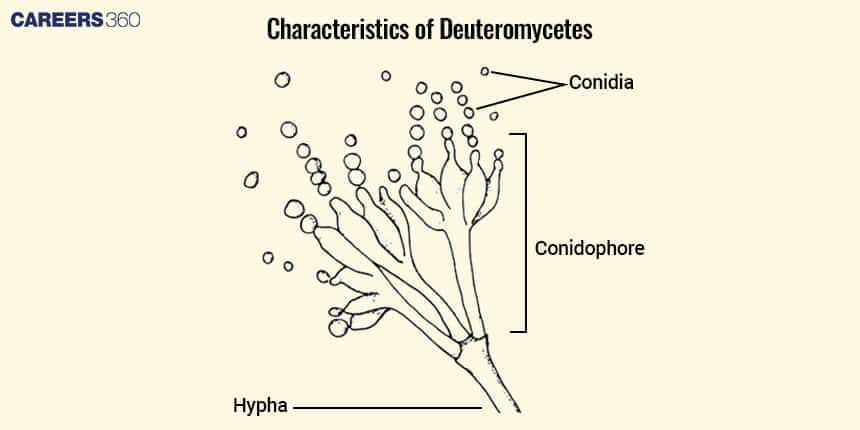Deuteromycetes - Fungus, Reproduction, Characteristics, Imperfect
Fungi are classified into four major phyla based on their mode of reproduction and the types of spores they produce. Deuteromycetes also known as Fungi Imperfecti, are characterised by a lack of sexual reproduction in their life cycle. They reproduce asexually through conidia.They are necessary for decomposition and nutrient cycling in the ecosystem. Many are harmful or used in biocontrol and antibiotics.
This Story also Contains
- Introduction to Deuteromycetes
- Classification of Deuteromycetes
- Characteristics of Deuteromycetes
- Diagram of Deuteromycetes Structure
- Examples of Deuteromycetes
- Why are Deuteromycetes Called "Fungi Imperfecti"?
- Economic Importance and Significance
- Deuteromycetes NEET MCQs
- FAQs on Deuteromycetes
- Recommended Video on Deuteromycetes

Explore Deuteromycetes (Fungi Imperfecti)—fungi lacking a known sexual stage, vital in decomposition, industry, and agriculture. Learn classification, characteristics, examples, and economic significance with NEET-focused notes. Includes diagrams, comparative tables, and MCQs for Class 11–12 Biology. Deutomycetes is a topic included in the chapter Biological Classification in Biology.
Introduction to Deuteromycetes
Deuteromycetes, also called fungi imperfecti, are fungi whose sexual stage has not been found yet. Earlier, scientists grouped them separately because there were no sexual spores produced. Instead, these fungi are identified based on their asexual spores and how they reproduce sexually.
Deuteromycetes are closely related belonging to different fungal groups. When scientists discover their sexual stage using advanced methods, they are placed into other groups like Ascomycota or Basidiomycota. Even so, Deuteromycetes are very important because they help break down dead material, are used in industries, and some can cause diseases.
Classification of Deuteromycetes
The group Deuteromycetes is classified into 4 orders. The four orders, along with some characteristics and some examples, are given in the table below-
Order | Key Characteristics | Examples |
Moniliales | Asexual spores (conidia) formed on free hyphae; saprophytic or parasitic; common moulds | Aspergillus, Penicillium |
Sphaeropsidales | Conidia are produced in flask-shaped structures called pycnidia | Phyllosticta, Colletotrichum |
Melanconiales | Conidia are produced in acervuli (flat, cushion-like fruiting bodies) | Diplodia, Gloeosporium |
Mycelia Sterilia | No conidia or reproductive structures observed; reproduces only by vegetative means | Rhizoctonia, Sclerotium |
Characteristics of Deuteromycetes
Deuteromycetes can be characterised on the basis of habitat, growth, pathogenicity, and their biocontrol nature. These are highlighted in the pointers below.
Habitat Diversity: They are commonly found in soil, decaying matter, and as plant or animal pathogens, showing wide ecological adaptability.
Rapid Growth: Many Deuteromycetes grow quickly and vigorously, which makes them dominant in environments with rich organic content.
Plant Pathogens: Many cause serious plant diseases like leaf spots, wilts, and blights, which can affect crop yield and quality.
Biocontrol Agents: Certain species (e.g., Trichoderma) are used as natural biocontrol agents, helping in sustainable agriculture by suppressing soil-borne diseases.
Toxin Production: Some species produce mycotoxins, which can contaminate food and pose risks to humans and animals (e.g., Fusarium).
Diagram of Deuteromycetes Structure
The diagram below shows the structure of Deuteromycetes along with its components. Conidia are asexual, non-motile spores produced by certain fungi for reproduction. They are borne on special structures called conidiophores, which arise from the hyphae—the thread-like filaments that make up the body of a fungus and help in nutrient absorption and growth.

Examples of Deuteromycetes
Some examples of deuteromycetes are given below:-
Trichoderma - Used in the biocontrol of plant diseases.
Alternaria - Causes leaf spots in plants.
Colletotrichum - Causes anthracnose disease in crops.
Helminthosporium - Causes blight in cereal crops.
Fusarium - Produces microtoxins and causes wilting in plants.
Aspergillusn- Used in fermentation and industrial enzyme production.
Candida - A yeast that causes human infections.
Why are Deuteromycetes Called "Fungi Imperfecti"?
Deuteromycetes are called fungi imperfecti because their sexual stage is either absent or not yet discovered. As a result, they cannot be classified into other well-defined fungal groups that rely on sexual reproduction. When their sexual forms are identified, they are often reclassified into Ascomycetes or Basidiomycetes.
Economic Importance and Significance
Deuteromycetes, or fungi imperfecti, play an important role in both natural ecosystems and human activities. While many species are beneficial in industry, agriculture, and medicine, others cause serious damage to crops, stored food, and even human health. Their economic significance can be seen in the following ways:
Decomposition and nutrient cycling – Many species act as saprophytes, decomposing organic matter and recycling nutrients in the ecosystem.
Industrial uses – Some produce useful enzymes, organic acids, and antibiotics (e.g., Trichoderma for enzymes, Penicillium notatum in related groups for penicillin).
Biological control agents – Certain species like Trichoderma are used to control plant pathogens.
Food spoilage – Many cause spoilage of fruits, vegetables, and stored grains, leading to economic losses.
Plant diseases – Some are serious plant pathogens, e.g., Alternaria causes leaf spots, Colletotrichum causes anthracnose.
Medical importance – A few species are pathogenic to humans and animals, causing skin diseases like ringworm.
Deuteromycetes NEET MCQs
Q1. The imperfect fungi which are decomposers of litter and help in mineral cycling belong to :
Basidiomycetes
Phycomycetes
Ascomycetes
Deuteromycetes
Correct answer: 4) Deuteromycetes
Explanation:
Deuteromycetes, or imperfect fungi, have a branched, filamentous, and septate mycelium. They can be saprophytic, parasitic, or decomposers, which plays a vital role in nutrient cycling. Asexual reproduction occurs by the formation of conidiospores. Sexual reproduction is absent in this group, and that is why they are termed "imperfect." Many Deuteromycetes are very important decomposers of organic litter, playing a very important role in mineral cycling in ecosystems.
Hence the correct answer is Option (4) Deuteromycetes
Q2. Which one is the wrong pairing for the disease and its causal organism?
Black rust of wheat-Puccinia graminis
Loose smut of wheat-Ustilago nuda
Root-knot of vegetables-Meloidogyne sp
Late blight of potato-Alternaria solani
Correct answer: 4) Late blight of potato-Alternaria solani
Explanation:
The late blight of potatoes is a fungal disease, caused by a fungus named Phytophthora infestans. The Alenternaria solani causes early blight of potatoes. The late blight of potatoes is a fungal disease caused by Phytophthora infestans, while Alternaria solani is responsible for early blight. Late blight spreads rapidly in cool, wet conditions and leads to water-soaked lesions on leaves stems, and tubers, often resulting in plant death. It was the primary cause of the Irish Potato Famine in the 19th century. The disease spreads through infected soil, plant debris, and windborne spores. Effective control measures include resistant potato varieties, proper crop rotation, fungicide application, and eliminating infected plant material.
Hence, the correct answer is option 4) Late blight of potato-Alternaria solani
Q3. Which of the following group of fungi produces cyclosporin A
Imperfect Fungi
Sac Fungi
Club Fungi
Algal Fungi
Correct answer: 1) Imperfect Fungi
Explanation:
Trichoderma is a Deuteromycetes fungus widely used as a biological control agent against plant-pathogenic fungi due to its ability to produce antifungal compounds and enzymes that suppress fungal growth. It is commonly used in agriculture to promote plant health by improving disease resistance and enhancing soil quality.
Hence, the correct answer is option 1) Imperfect Fungi.
Also Read:
FAQs on Deuteromycetes
What are Deuteromycetes?
Deuteromycetes, also called fungi imperfecti, are a group of fungi in which the sexual stage is absent or not yet discovered. The sexual stage is considered as the perfect stage. They reproduce only by asexual spores called conidia. Many are saprophytic, while some are parasitic or pathogenic. Examples include Alternaria, Colletotrichum, and Trichoderma.
What are they called fungi imperti?
Deuteromycetes are called fungi imperfecti because only they reproduce by asexual mode. The sexual stage is considered as the perfect stage and it is either absent or has not been observed in their life cycle.
What are the Deuteromycetes classified?
Deuteromycetes have no sexual stage, they reproduce only by asexual spores called conidia, produced on conidiophores. The mycelium is septate and branched. Most species are terrestrial, found in soil or on decaying organic matter, while some are parasitic on plants and animals. They play an important role in decomposition and nutrient cycling but some cause plant diseases and food spoilage.
What is the structure of conidia and conidiophores?
Conidia are non-motile, asexual spores, usually single-celled or multicellular, produced exogenously. They are borne on special stalk-like structures called conidiophores, which may be branched or unbranched. Conidiophores arise from the mycelium and bear conidia at their tips or sides.
Recommended Video on Deuteromycetes
Frequently Asked Questions (FAQs)
More about the economic importance of Deuteromycetes is its role in antibiotic production responsible for penicillin from species of the genus Penicillium and industrial enzymes used either in food processing or pharmaceuticals.
Habitats of deuteromycetes usually include different environments such as soil, decaying organic matter, aquatic habitats, and living hosts. Quite often, they develop most actively on forest floors, in compost heaps, or in various substrata rich in organic matter.
Deuteromycetes differ from other fungi mainly by the inability to recognise a sexual phase of their life cycle. Whereas most fungi are classified based on their sexual along with asexual reproductive structure, the Deuteromycetes are named and classified only on asexual grounds.
Deuteromycetes can be either saprophytic or parasitic. Many Deuteromycetes are decomposers that feed on dead organic matter, while some are parasites that cause diseases in plants and animals. For example, Deuteromycetes like Alternaria and Colletotrichum are known to cause plant diseases, while others like Aspergillus can be found in a variety of environments, including decaying organic matter.
Deuteromycetes reproduce mainly by asexual means, with the key reproductive organ being the conidia spores. This gives rise to spores that later develop into specialised structures called conidiophores. After that, they are dispersed to new environments where they germinate and grow into new mycelia.